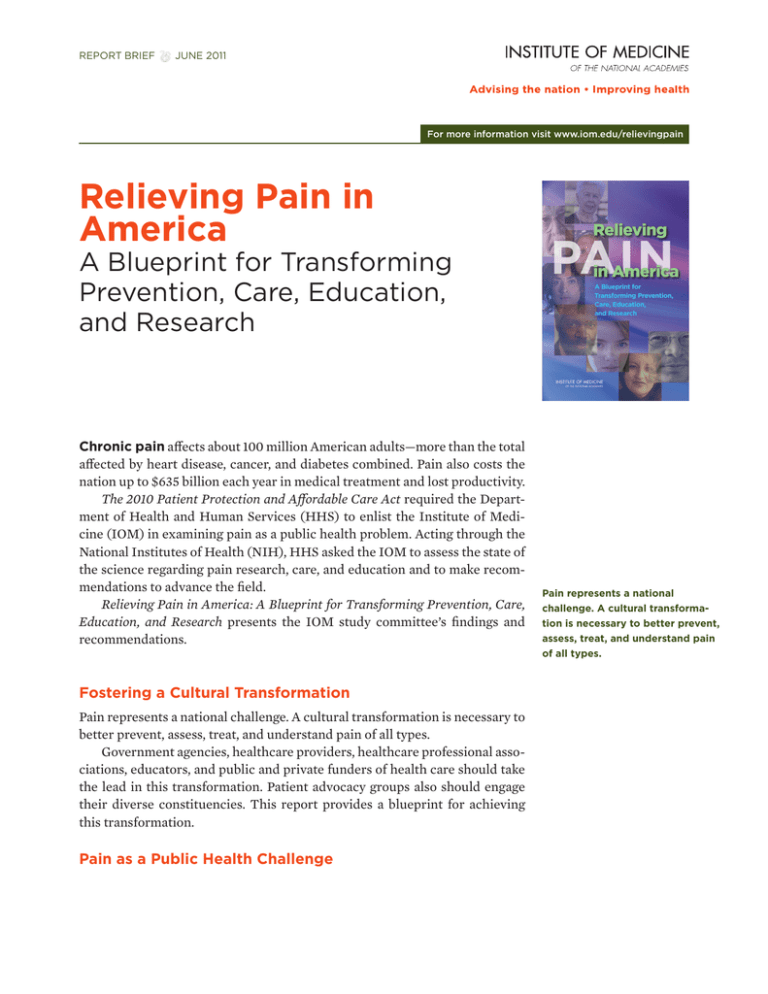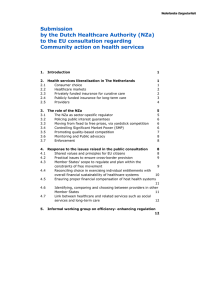
REPORT BRIEF JUNE 2011
For more information visit www.iom.edu/relievingpain
Relieving Pain in
America
A Blueprint for Transforming
Prevention, Care, Education,
and Research
Chronic pain affects about 100 million American adults—more than the total
affected by heart disease, cancer, and diabetes combined. Pain also costs the
nation up to $635 billion each year in medical treatment and lost productivity.
The 2010 Patient Protection and Affordable Care Act required the Department of Health and Human Services (HHS) to enlist the Institute of Medicine (IOM) in examining pain as a public health problem. Acting through the
National Institutes of Health (NIH), HHS asked the IOM to assess the state of
the science regarding pain research, care, and education and to make recommendations to advance the field.
Relieving Pain in America: A Blueprint for Transforming Prevention, Care,
Education, and Research presents the IOM study committee’s findings and
recommendations.
Fostering a Cultural Transformation
Pain represents a national challenge. A cultural transformation is necessary to
better prevent, assess, treat, and understand pain of all types.
Government agencies, healthcare providers, healthcare professional associations, educators, and public and private funders of health care should take
the lead in this transformation. Patient advocacy groups also should engage
their diverse constituencies. This report provides a blueprint for achieving
this transformation.
Pain as a Public Health Challenge
Pain represents a national
challenge. A cultural transformation is necessary to better prevent,
assess, treat, and understand pain
of all types.
Care of People with Pain
To reach the vast multitude of people with various types of pain, the nation must adopt a population-level prevention and management strategy.
HHS should develop a comprehensive plan with
specific goals, actions, and timeframes. The plan
should:
People with pain receive care in various ways,
including assistance with self-management, primary care, specialty care, and pain clinics, among
others. Treatments can include medications,
surgery, behavioral interventions, psychological
counseling, rehabilitative and physical therapy,
and complementary and alternative therapies. For
many people, however, pain prevention, assessment, and treatment are inadequate.
Among steps to improving care, healthcare
providers should increasingly aim at tailoring
pain care to each person’s experience, and selfmanagement of pain should be promoted. Also,
primary care physicians—who handle most frontline pain care—should collaborate with pain specialists in cases where pain persists. Public and
private insurers can help by offering incentives
to support the delivery by primary care providers
of coordinated, evidence-based, interdisciplinary
pain assessment and care for persons with complex pain.
A number of barriers—including regulatory,
legal, institutional, financial, and geographical
barriers—limit the availability of pain care and
contribute to the disparities found among some
groups. Government agencies, healthcare providers, and public and private funders of health care
should adopt a comprehensive, strategic approach
to reduce or eliminate these barriers.
• heighten awareness about pain and its health
consequences;
• emphasize the prevention of pain;
• improve pain assessment and management in
the delivery of healthcare and financing programs of the federal government;
• use public health communication strategies to
inform patients on how to manage their own
pain; and
• address disparities in the experience of pain
among subgroups of Americans.
Better data are needed to help shape efforts.
Although pain is known to be prevalent across
society, reliable data are lacking on the full scope
of the problem, especially among those currently
underdiagnosed and undertreated, including
racial and ethnic minorities; people with lower
levels of income and education; women, children,
and older people; military veterans; surgery and
cancer patients; and people at the end of life;
among others. Therefore, the National Center for
Health Statistics, Agency for Healthcare Research
and Quality (AHRQ), other federal and state agencies, and private organizations should accelerate
the collection of data on pain incidence, prevalence, and treatments. Data should be collected
at regular intervals using standardized questions,
protocols for surveys, and electronic medical
records to identify the following information:
Education Challenges
Across health care and society alike, there are
major gaps in knowledge about pain. Educating
health professionals about how to better understand pain and its causes will help bridge these
gaps.
To improve patient and public understanding
of pain, federal agencies and other stakeholders
should redesign education programs. They should
aim to foster an understanding among patients,
the public, and healthcare providers that there
are complex biological and psychosocial aspects
• subpopulations at risk;
• characteristics of acute and chronic pain;
• profound health consequences of pain, including death, disease, and disability; and
• related trends over time.
2
Among steps to improving care,
healthcare providers should
increasingly aim at tailoring pain
care to each person’s experience
and self-management of pain
should be promoted. Also, primary
care physicians—who handle most
front-line pain care—should
collaborate with pain specialists
in cases where pain persists.
to pain, and they should develop materials about
the nature of pain; ways to use self-help strategies
to prevent, cope with, and reduce pain; and available treatments for pain. The materials should be
specifically targeted to patients, the public, and
healthcare providers.
To increase understanding among the array of
health professionals who deal with pain, undergraduate and graduate training programs should
offer standardized information about pain and
include experience in caring for pain in interprofessional settings. Improving education is especially important for primary care providers, given
their key role in pain management. In addition,
all care providers should keep their knowledge
current by engaging in continuing education programs; and licensure, certification, and recertification examinations should include assessments
of providers’ pain education.
to enable more efficient evaluation and approval
of potentially effective therapies. This will be
especially important as personalized medicine
approaches to pain management develop. At present, however, federal dollars for pain research are
in short supply and likely to decrease. Moreover,
the responsibility for pain research is spread thin.
The committee recommends that an existing
NIH institute be designated the lead institute for
pain. It also recommends that the NIH Pain Consortium take a stronger leadership role in effecting the necessary transformation in how pain
research is conducted, by fostering coordination
across institutes and centers, by improving study
section decision making on pain proposals, and by
exploring a range of potential public-private initiatives.
The need for pain-related research is not
confined to the NIH. Research into the prevention, occurrence, and costs of pain and the delivery and financing of pain treatment are of concern to many public health entities, for example,
the Centers for Disease Control and Prevention,
for epidemiological data and public education
strategies; AHRQ, for quality improvement; the
Health Resources and Services Administration,
with respect to professional education and service delivery for vulnerable populations; and the
Centers for Medicare and Medicaid Services, for
reimbursement-related research and demonstration programs.
Research Challenges
Research has made remarkable strides in understanding the biological, cognitive, and psychological underpinnings of pain, and the future promises advances in a number of fields—from genomic
and cellular through behavioral mechanisms. Still,
many gaps persist, and developing more effective
and less risky pain relievers remains a major challenge. Additional challenges exist when trying to
use advances in the implementation sciences to
help translate effective treatments from research
into practice and to adapt the regulatory process
3
Committee on Advancing Pain Research, Care, and Education
Philip A. Pizzo (Chair)
Dean, Carl and Elizabeth
Naumann Professor of Pediatrics
and of Microbiology and Immunology, Stanford University
School of Medicine, Stanford, CA
Janice S. Lee
Associate Professor, Department of Oral and Maxillofacial
Surgery, School of Dentistry,
University of California, San
Francisco, CA
Noreen M. Clark (Vice Chair)
Myron E. Wegman Distinguished University Professor;
Director, Center for Managing
Chronic Disease, University of
Michigan, Ann Arbor, MI
Elizabeth Loder
Chief, Division of Headache
and Pain, Department of
Neurology, Brigham and
Women’s and Faulkner Hospitals; Associate Professor of
Neurology, Harvard Medical
School, Boston, MA
Olivia Carter-Pokras
Associate Professor, Department of Epidemiology and Biostatistics, University of Maryland
College Park School of Public
Health, College Park, MD
Myra Christopher
President and CEO, Kathleen M.
Foley Chair in Pain and Palliative Care, Center for Practical
Bioethics, Kansas City, MO
John T. Farrar
Associate Professor of Epidemiology; Director, Master of
Science in Clinical Epidemiology, Center for Clinical
Epidemiology and Biostatistics,
University of Pennsylvania,
Philadelphia, PA
Kenneth A. Follett
Professor and Chief of Neurosurgery, Division of Neurosurgery, University of Nebraska
Medical Center, Omaha, NE
Margaret M. Heitkemper
Elizabeth Sterling Soule Chair;
Professor and Chairperson,
Department of Biobehavioral
Nursing and Health Systems,
University of Washington,
Seattle, WA
Charles Inturrisi
Professor of Pharmacology,
Weill Cornell Medical College,
Pharmacology, New York, NY
Francis Keefe
Professor, Department of
Psychiatry and Behavioral
Sciences; Director, Duke Pain
Prevention and Treatment
Research Program, Professor of
Psychology and Neuroscience,
Durham, NC
Robert D. Kerns
National Program Director for
Pain Management, VA Central
Office; Director, Pain Research,
Informatics, Medical Comorbidities, and Education (PRIME)
Center, VA Connecticut; Professor of Psychiatry, Neurology
and Psychology, Yale University
PRIME Center, VA Connecticut Healthcare System, West
Haven, CT
Sean Mackey
Associate Professor, Departments of Anesthesia, Neuroscience and Neurology; Chief for
the Division of Pain Management, Stanford University School
of Medicine, Palo Alto, CA
Rick Marinelli
Naturopathic Physician and
Acupuncturist Clinic Director, Natural Medicine Clinic,
Portland Vein Clinic; Diplomate,
American Academy of Pain
Management; Commissioner,
Oregon Pain Management
Commission, Portland, OR
Richard Payne
Professor of Medicine and Divinity, Esther Colliflower Director, Duke Institute on Care at
the End of Life, Duke University
Divinity School, Durham, NC
Melanie Thernstrom
Contributing Writer, The New
York Times Magazine, Vancouver, WA
Dennis C. Turk
John and Emma Bonica Professor of Anesthesiology and
Pain Research; Director, Center
for Pain Research on Impact,
Measurement, and Effectiveness (C-PRIME), Department
of Anesthesiology & Pain Medicine, University of Washington,
Seattle, WA
Ursula Wesselmann
Edward A. Ernst Endowed Professor of Anesthesiology, Professor of Neurology, University
of Alabama at Birmingham,
Department of Anesthesiology, Division of Pain Medicine,
Birmingham, AL
Blueprint for Action
The committee offers a blueprint for action in
transforming prevention, care, education, and
research, with the goal of providing relief for people with pain in America. The blueprint prioritizes
the committee’s recommendations. While some
recommendations should be implemented by the
end of 2012—including developing a comprehensive strategy, developing strategies to reduce barriers in care, supporting collaboration between pain
specialists and primary care clinicians, and designating a lead institute at the NIH that is responsible for moving pain research forward—all other
recommended actions must build on these shortterm achievements and should be taken soon afterward. These other actions must be ongoing efforts
that should be firmly developed and put in place by
the end of 2015.
The strategy should be comprehensive in
scope, inclusive in its development, expeditious
in its implementation, and practical in its application. Most importantly, the strategy must be farreaching. As evidenced in this report, pain is a major
driver for visits to physicians and other healthcare
providers, a major reason for taking medications, a
major cause of disability, and a key factor in quality
of life and productivity. Given the burden of pain
in human lives, dollars, and social consequences,
relieving pain should be a national priority. f
Lonnie Zeltzer
Director, Pediatric Pain
Program, Mattel Children’s
Hospital at UCLA; Professor
of Pediatrics, Anesthesiology,
Psychiatry and Biobehavioral
Sciences, David Geffen School
of Medicine at the University of
California, Los Angeles, CA
Study Staff
Adrienne Stith Butler
Study Director
Jing Xi
Research Associate
Thelma L. Cox
Senior Program Assistant
Andrew M. Pope
Director, Board on Health
Sciences Policy
Study Sponsor
The National Institutes of Health
Revised March 2012
Donna Randall
Assistant, Board on Health
Sciences Policy
Victoria Bowman
Financial Associate
500 Fifth Street, NW
Washington, DC 20001
TEL 202.334.2352
FAX 202.334.1412
www.iom.edu
The Institute of Medicine serves as adviser to the nation to improve health.
Established in 1970 under the charter of the National Academy of Sciences,
the Institute of Medicine provides independent, objective, evidence-based advice
to policy makers, health professionals, the private sector, and the public.
Copyright 2011 by the National Academy of Sciences. All rights reserved.


